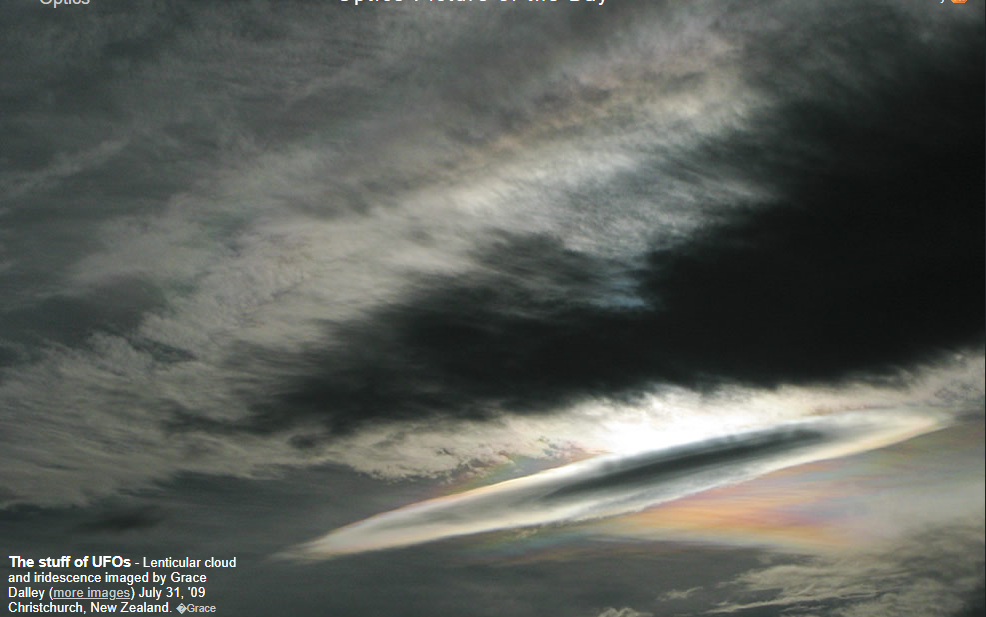Lenticular & Iridescence
Lenticular & Iridescence: Unveiling the Enigmatic Sky Spectacles
The mesmerizing phenomena of lenticular clouds and iridescence continue to captivate sky gazers worldwide. These atmospheric optical wonders add an ethereal touch to our celestial tapestry, leaving us in awe of their beauty and mystery. In this article, we will delve deeper into the enchanting world of lenticular clouds and iridescence, unraveling the science behind these captivating spectacles.
The Intriguing Lenticular Clouds
Lenticular clouds, often compared to flying saucers or UFOs, are characterized by their unique lens-shaped structure. These stunning cloud formations are created when moist air encounters a mountain or hill, causing it to rise rapidly. As the air ascends, it cools and condenses into droplets, forming the base of the cloud. The air then descends on the leeward side of the mountain, leading to a wave-like pattern that gives lenticular clouds their distinctive appearance.
A Kaleidoscope of Colors: Iridescence in Lenticular Clouds
One of the most fascinating aspects of lenticular clouds is their iridescence. When sunlight interacts with the tiny water droplets within these clouds, the light undergoes a process known as diffraction. This phenomenon causes the light waves to bend and scatter, resulting in the separation of colors and the creation of vibrant hues. The droplets within lenticular clouds are typically uniform in size, allowing for consistent diffraction and intense iridescence.
Beyond the Main Cloud: Exploring External Iridescence
While the main body of a lenticular cloud exhibits remarkable iridescence, the surrounding sky can also contribute to this captivating display. External iridescence occurs when sunlight interacts with ice crystals or other atmospheric particles present in the vicinity of the cloud. These additional sources of diffraction enhance the overall spectacle, creating a complex and mesmerizing sky.
Unveiling the Enigma: Scientific Insights into Lenticular Clouds
Although lenticular clouds have long been associated with extraterrestrial sightings due to their peculiar appearance, they are purely natural phenomena. Scientists continue to study these clouds to gain a deeper understanding of their formation and behavior. Through advanced meteorological research and computer simulations, experts have been able to shed light on the intricate dynamics that give rise to lenticular clouds.
The Role of Atmospheric Stability: Unraveling Lenticular Cloud Formation
The formation of lenticular clouds is heavily influenced by atmospheric stability. When stable air encounters a mountain or hill, it is forced to rise and descend in a predictable manner, creating the characteristic wave pattern. Understanding the interplay between air temperature, moisture content, and topography allows scientists to predict when and where lenticular clouds are likely to form.
A Global Phenomenon: Lenticular Clouds Around the World
Lenticular clouds can be observed in various parts of the world, although they are most commonly associated with mountainous regions. These cloud formations have been spotted in locations such as New Zealand, Switzerland, the United States, and many other countries. Their prevalence in mountainous areas is due to the unique atmospheric conditions created by the interaction of moist air with elevated terrain.
Iridescence Beyond Lenticular Clouds: A Colorful Symphony in the Sky
While lenticular clouds are renowned for their iridescence, this captivating optical phenomenon can occur in other atmospheric conditions as well. Iridescence can be observed in high-altitude clouds, such as cirrus clouds, as well as in thin layers of ice crystals or water droplets suspended in the atmosphere. These mesmerizing displays of color are a testament to the intricate interplay between light and the particles present in our atmosphere.
The Artistic Appeal: Inspiring Artists and Photographers
The ethereal beauty of lenticular clouds and iridescence has not gone unnoticed by artists and photographers. The enchanting colors and surreal shapes have served as inspiration for countless works of art and stunning photographs. Capturing the elusive nature of these sky spectacles requires both patience and a keen eye, as their transient nature adds an element of spontaneity to the creative process.
Embracing the Mysteries of the Sky
As we gaze upon the enchanting lenticular clouds and iridescent skies, we are reminded of the vast wonders that lie beyond our earthly realm. These atmospheric optical phenomena serve as a reminder of the intricate and interconnected nature of our world. While science continues to unravel the secrets behind these celestial spectacles, there will always be an element of wonder and awe that accompanies our exploration of the enigmatic sky. So, next time you find yourself captivated by a lenticular cloud or a kaleidoscope of colors in the sky, take a moment to appreciate the beauty and mystery that lies above us.

The stuff of UFOs - Lenticular cloud and iridescence imaged by Grace Dalley (more images) July 31, '09 Christchurch, New Zealand. �Grace Dalley, shown with permission.
The cigar shaped lenticular looms ominously in the strongly backlit sky.
Lenticulars are famously iridescent. They are wave clouds where rising air enters one side, cools and droplets condense. The air pocket then starts to descend on the wave, heats and the drops evaporate - edge of cloud. Fresh drops with all the same history are same sized and give intense iridescence.
This sky is complex and much of the iridescence is external to the main cloud.
Note: this article has been automatically converted from the old site and may not appear as intended. You can find the original article here.
Reference Atmospheric Optics
If you use any of the definitions, information, or data presented on Atmospheric Optics, please copy the link or reference below to properly credit us as the reference source. Thank you!
-
<a href="https://atoptics.co.uk/blog/lenticular-iridescence/">Lenticular & Iridescence</a>
-
"Lenticular & Iridescence". Atmospheric Optics. Accessed on November 26, 2024. https://atoptics.co.uk/blog/lenticular-iridescence/.
-
"Lenticular & Iridescence". Atmospheric Optics, https://atoptics.co.uk/blog/lenticular-iridescence/. Accessed 26 November, 2024
-
Lenticular & Iridescence. Atmospheric Optics. Retrieved from https://atoptics.co.uk/blog/lenticular-iridescence/.